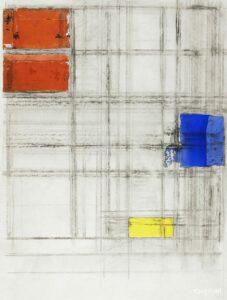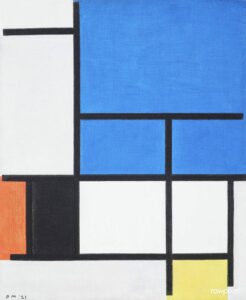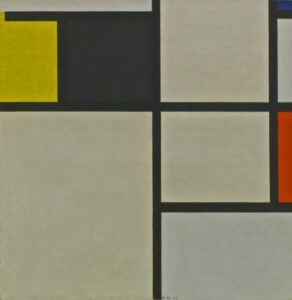Neoplasticism is a striking artistic movement that strips away the frills to reveal art in its purest form.
Think bold colors, straight lines, and an emphasis on the absolute essentials.
We’ll take you through the roots of Neoplasticism, introducing you to its pioneering figures like Piet Mondrian who sought to transform the way we perceive art.
Get ready to explore a world where simplicity reigns supreme and every form has a purpose.
Origins Of Neoplasticism
Neoplasticism emerged in the early 20th century, conceived as a response to the chaotic aftermath of World War I.
The movement was an Try to reflect a new utopian ideal of order and harmony.
It was a rebirth from the ruins that sought to remodel society through the lens of art and design.
The term “Neoplasticism” was coined by Piet Mondrian, who, along with Theo van Doesburg, laid the philosophical foundations for this stark aesthetic.
Their goal was to strip art down to its fundamental aspects – unraveling the complexity of forms to evoke a sense of stability and balance.
- Philosophical roots can be traced to: – Cubism, which challenged conventional forms of perspective – Theosophy, an esoteric belief system advocating spiritual harmony.
Mondrian’s compositions, characterized by a grid of vertical and horizontal lines and a palette limited to primary colors, were the epitome of Neoplastic theory put into practice.
These art pieces illustrated a profound simplicity, reflecting the movement’s core principles.
The spread of Neoplasticism was further propelled through the journal De Stijl, edited by van Doesburg.
The publication connected a community of architects, artists, and designers, all united by the shared language of Neoplastic principle.
This collaborative environment allowed the movement to infuse into the broader culture.
Key Elements Of Neoplasticism
To fully understand Neoplasticism, one must become familiar with its defining characteristics.
Here are the movement’s essential components:
- A palette restricted to the primary colors and noncolors (black, white, and grey),
- The use of straight lines and right angles,
- Asymmetrical balance achieved through the precise application of these elements.
By adhering to these constraints, Neoplastic artworks aimed to achieve universal beauty and convey an absolute sense of truth beyond the subjective experience.
This pursuit of artistic purity continues to inspire filmmakers and designers, reminding us that complexity isn’t a prerequisite for profound expression.
Piet Mondrian: The Pioneer Of Neoplasticism
Piet Mondrian is a name synonymous with Neoplasticism.
His work laid the groundwork for the movement, and his dedication to form, colour, and line is unrivaled.
Mondrian’s art is marked by a rigorous adherence to the philosophy of pure abstraction; his pieces are studies in precision and a quest for spiritual harmony.
Mondrian’s transition from figurative painting to abstract work signals the bold steps he took toward the creation of Neoplasticism.
Works such as Broadway Boogie Woogie showcase the distinct style he is celebrated for – a grid-based composition, primary colours interspersed with black lines, and a dynamic energy that contradicts the apparent simplicity of the form.
We cannot mention Mondrian without referencing specific elements that define his contributions to Neoplasticism:
- Use of a predominantly white background to enhance the vibrancy of primary colours,
- Creation of a new visual language through a limited palette and geometric precision,
- An approach that went beyond painting, influencing fields like architecture, design, and even cinematography.
The evolution of Mondrian’s style is a testament to Neoplasticism’s impact on the broader visual arts.
His legacy is evident in modern-day graphic design, where simplicity and clarity are
As filmmakers, we draw inspiration from Mondrian’s mastery of composition and balance, applying similar principles to frame our shots and craft our visual narratives.
In studying Mondrian’s life, we find a fervent belief in art as a transformative force.
Through his journey from figuration to abstraction, he consistently pursued the essence of beauty and truth, offering us lessons in both art and life.
His canvases are more than paintings; they are blueprints for a world where order and peace prevail.
https://youtube.com/watch?v=AstIV-VFDQ8

Characteristics Of Neoplasticism
Neoplasticism, the avant-garde art movement, is defined by its distinct use of form and color.
It serves as a beacon of Modernism, emphasizing a utopian ideal measured by harmony and rhythm in art.
Let’s jump into the core characteristics that make Neoplasticism stand out in the realm of artistic innovation.
The ethos of Neoplasticism is rooted in simplicity and abstraction.
Elaborate details and realism find no place in this movement; instead, the focus is on reducing elements to their most basic, universal essence.
With this in mind, one can detect the following traits in Neoplastic works:
- Restricted use of color – only primary colors plus black and white,
- Disavowal of symmetrical balance in favor of asymmetrical equilibrium,
- Precise application of straight, horizontal and vertical lines,
- Flat, unmodulated color planes devoid of depth or texture.
Piet Mondrian’s artworks, such as Broadway Boogie Woogie, epitomize Neoplasticism’s principles.
These paintings are more than mere visual objects; they’re visual manifestations of an underlying philosophical approach.
Mondrian sought a form of pure expression that transcended the transient nature of reality, offering instead a vision of a universally cohesive world.
Observing another aspect – Neoplasticism’s influence can also be seen beyond the canvas.
In fields like architecture and design, this movement endorses a minimalist approach yet allows for a profound impact.
The work of architect Gerrit Rietveld, evidenced in the Rietveld Schröder House, exemplifies how Neoplastic principles can be translated into spatial design.
This symbiosis between visual arts and architecture underscores the versatility and depth of the movement.
We recognize the cinematic influence as well.
Filmmakers often draw from Neoplasticism’s visual language, constructing scenes through geometric framing and a restrained color palette to evoke the same sense of calm and balance found in Mondrian’s paintings.
One sees echoes of Mondrian’s flat planes in the stark compositional style of directors like Wes Anderson or the meticulous mise-en-scène techniques of Stanley Kubrick.
The Power Of Colors In Neoplasticism
When exploring Neoplasticism, we can’t overlook the profound influence that color choices have on the movement’s aesthetic.
Colors in Neoplasticism are not used to represent the natural world, but rather to evoke a sense of harmony and balance.
The stark contrasts and intense clarity of primary colors against whites, blacks, and grays are hallmarks that define this movement.
Mondrian’s Composition with Red, Blue, and Yellow serves as a testament to this deliberate use of color.
The painting’s restricted palette and the strategic placement of colors demonstrate:
- The use of primary colors as a visual foundation,
- The employment of white spaces to create a feeling of non-restriction,
- The delineation of spaces with black lines to maintain structure.
In Neoplasticism, filmmakers and designers borrow these same principles to convey messages through color.
Unlike traditional cinema that relies on a broad color spectrum to tell a story, filmmakers inspired by Neoplasticism might select a limited palette to deliver a more powerful visual experience.
Our understanding of Neoplasticism in art deepens when we consider the purposeful application of color.
We appreciate how color’s restrictive use works to strip away the superfluous and focus the viewer on fundamental elements.
By limiting color, movements and emotions on screen become more poignant.
Through this lens, viewers are encouraged to find beauty in simplicity and order – a reflection of Mondrian’s vision of a cohesive world.
It’s imperative for us as filmmakers and artists to grasp how Neoplasticism can elevate our visual storytelling.
The movement’s color theory can be implemented in various creative fields, pushing boundaries and crafting compelling narratives with minimalistic yet bold visual cues.
Simplicity And Purpose: The Essence Of Neoplasticism
Neoplasticism has long been a beacon for purists in art and design, calling for a reduction to the essentials of form and color.
We recognize it as an art movement that strips complexity away, urging us to ponder the basics of visual composition.
Through this lens, art transcends mere representation and becomes a philosophical statement about the nature of existence.
Our understanding deepens when we see how these artists favored universal beauty over individual expression.
They pursued a visual language that anyone, anywhere could appreciate – finding common ground through:
- Universal forms and colors,
- A balance between space and line,
- The rhythm generated by asymmetric layouts.
Piet Mondrian’s Broadway Boogie Woogie serves as an embodiment of Neoplasticism’s aesthetic principles.
Its grid-like patterns and limited color palette craft an image bustling with urban rhythm and dynamic energy.
Here, art isn’t just seen; it’s felt, highlighting the deeper purpose behind the simplicity.
As filmmakers, we draw inspiration from the methodical use of space and color within Neoplasticism.
By applying these principles to our visual storytelling, we create a distinctive narrative flow – one that captures the essential mood or concept without unnecessary ornamentation.
We find power in plainness, leveraging:
- Precise framing and composition,
- Controlled color schemes for thematic emphasis,
- Intentional pacing to direct audience focus.
Our goal is less about depicting the world as it is and more about presenting it through a prism of formative elements.
Whether it’s in the form of a gripping scene or a stylized set design, we aim to evoke emotion and thought through the minimalist approach that Neoplasticism champions.
What Is Neoplasticism In Art – Wrap Up
We’ve delved into the profound simplicity of Neoplasticism, appreciating its dedication to the essence of form and color.
Through the lens of this movement, we’ve seen how art transcends the canvas, influencing other creative realms with its distinct aesthetic.

It’s clear that the impact of Neoplasticism extends beyond its time, continuing to inspire a quest for harmony and universal beauty in art and beyond.
As we reflect on the enduring legacy of this movement, we’re reminded that sometimes the most profound statements are made with the simplest of compositions.

Frequently Asked Questions
What Is Neoplasticism?
Neoplasticism is an artistic movement that emphasizes simplicity and fundamental aspects of visual composition, using basic geometric forms and primary colors.
Who Is A Notable Artist Associated With Neoplasticism?
Piet Mondrian is a notable artist associated with Neoplasticism, famous for works like “Broadway Boogie Woogie.
“
What Does Neoplastic Art Aim To Transcend?
Neoplastic art aims to transcend mere representation, making a philosophical statement about the nature of existence.
How Does Neoplastic Art Achieve Universal Beauty And Balance?
Neoplastic art achieves universal beauty and balance through the use of restricted geometric forms and a limited palette, which creates harmony and equilibrium.
What Is The Significance Of Asymmetric Layouts In Neoplastic Art?
Asymmetric layouts in Neoplastic art introduce rhythm and dynamic balance, deviating from traditional symmetry to create visual interest.
How Do Filmmakers Utilize Neoplasticism Principles In Their Work?
Filmmakers apply Neoplasticism principles by using minimalist techniques in visual storytelling to evoke emotions and convey the essence of their narrative without unnecessary details.


